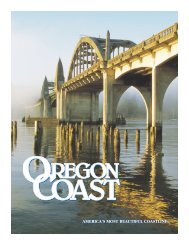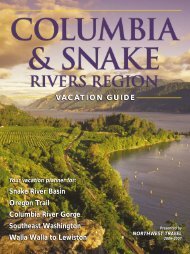Create successful ePaper yourself
Turn your PDF publications into a flip-book with our unique Google optimized e-Paper software.
OREGON<br />
<strong>Wine</strong> Terminology<br />
ACIDITY occurs naturally in grapes and indicates<br />
the quality of tartness, sourness, and sharpness of a<br />
wine. Acids in proper proportion give wine balance<br />
and character. Generally, the cooler the region, the<br />
higher the level of acid in the grapes.<br />
APPELLATION a recognized wine growing region<br />
governed by regulations established by its federal or<br />
local government. In the United States, appellations<br />
are referred to as American Viticultural Areas<br />
(AVAs). In British Columbia, they’re referred to as<br />
Designated Viticultural Areas (DVAs).<br />
BALANCE the interplay between sugar, acid, tannin,<br />
and alcohol. In a well-balanced wine, none of these<br />
elements dominate the wine.<br />
BODY the sensation of weight on the palate, ranging from light to heavy.<br />
BRIX the measurement of sugar content in unfermented grape juice,<br />
which is used to indicate the estimated alcohol a wine will produce on<br />
fermentation.<br />
DRY/OFF-DRY indicates a style of wine: no sugar = dry, a little<br />
residual sugar = off-dry.<br />
FERMENTATION (primary) the process by which grape juice<br />
becomes wine: a chain reaction of chemical processes whereby sugars<br />
in the grape juice are converted by the enzymes in yeasts into alcohol<br />
and carbon dioxide. This process is called primary fermentation; some<br />
wines undergo a secondary fermentation process.<br />
FERMENTATION (secondary) also called malolactic fermentation, a<br />
secondary fermentation turns malic acid (think apples) into lactic acid<br />
(think cream, vanilla, butter, and milk) adding another dimension to<br />
the wine. While all red wines undergo malolactic fermentation, white<br />
wines do not. This is essentially a stylistic preference accorded the<br />
winemaker, who may choose for the wine to undergo a full or partial<br />
secondary fermentation or none at all.<br />
FRUIT the single most important quality, it is the winemakers goal to<br />
capture the true essence of the variety used.<br />
ICEWINE is made from grapes frozen on the vine and then pressed<br />
before they thaw. The juice from these grapes is very concentrated and<br />
high in sugar and acid, with the resulting wines sweet, intense, and rich<br />
in flavor with excellent aging potential.<br />
LATE HARVEST grapes picked late in the season for maximum sugar<br />
content and typically for sweet or dessert wines.<br />
OAK wines aged or fermented in oak barrels take on toasty qualities and<br />
flavors of butter and vanilla for white wines, coffee and tobacco for reds.<br />
RESIDUAL SUGAR natural grape sugar that is either unfermented at the<br />
end of the fermentation process or added back into the wine as with<br />
dosage for sparkling wine. Residual sugar (r.s.) ranges from 0.1 to 0.2<br />
percent in dry wines to as high as 28 to 30 percent in late-harvest wines.<br />
STEEL wines fermented or aged in steel tanks emphasize fresh fruit in<br />
clear bright flavors.<br />
TANNIN comes from the skins, seeds, and stems of the grapes; adding<br />
longevity, structure, and complexity to the wine.<br />
VARIETAL refers to the type of wine grape variety: Merlot,<br />
Chardonnay, etc.<br />
VINIFERA premium wine grapes as opposed to table grapes. Vitis<br />
vinifera is the vine species that produces wine grapes. ■<br />
—Courtesy of the Washington <strong>Wine</strong> Commission.<br />
(www.washingtonwine.org)<br />
way diminishes the region’s standing in the<br />
Oregon wine industry.<br />
THE GRAPES<br />
The Umpqua Valley is warmer and drier<br />
than the Willamette Valley, but not as warm as<br />
the Rogue Valley, so cool-weather and warmweather<br />
varietals flourish in the area. All the<br />
popular Pinots, Cabernets, and Rieslings are<br />
grown in the Umpqua Valley, but such rare<br />
varietals as Baco noir and Seyval blanc can also<br />
be found there. Up and coming varietals in the<br />
area include Tempranillo, Syrah, and Viognier.<br />
WHEN TO VISIT<br />
During the spring and fall, visitors who<br />
drive from winery to winery in the Land of<br />
Umpqua pass roadside produce stands, an<br />
added treat to a day of wine tasting. Many of<br />
the wineries are closed from late December<br />
until mid-to-late January and a few are open by<br />
appointment only, so call ahead. For links to all<br />
things Umpqua, visit www.landofumpqua.com.<br />
TOURS/ROUTES<br />
The Umpqua <strong>Wine</strong> Tour Route starts about<br />
5 miles south of Roseburg at exit 119 off I–5.<br />
Head west toward Tenmile and pass three<br />
wineries on roads just off this main artery.<br />
Then head north toward Melrose and the<br />
Garden Valley area to visit more, and finally<br />
north along the Umpqua River to the final two<br />
in Elkton. For a map and more information,<br />
contact the Roseburg Visitors and Convention<br />
Bureau. (800-444-9584)<br />
AREA ATTRACTIONS<br />
Historical districts, covered bridges, waterfalls,<br />
recreational lakes, and the Seven Feathers<br />
Hotel and Casino Resort in Canyonville all<br />
await visitors to the Umpqua Valley. And<br />
Wildlife Safari in Winston doesn’t have to be<br />
fun just for the kids; drive through the 600-acre<br />
park and see the exotic animals as they roam<br />
freely in their natural habitats. Roseburg also is<br />
the starting point for the 172 miles of the<br />
Rogue–Umpqua National Scenic Byway.<br />
24 Northwest <strong>Wine</strong> Country <strong>2005</strong>/2006




